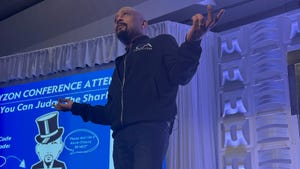In Morgan Stanley CEO Race, Wealth Boss Emerges as One to WatchIn Morgan Stanley CEO Race, Wealth Boss Emerges as One to Watch
The firm's wealth-management juggernaut has lifted Andy Saperstein from a long-shot candidate to a serious contender to replace James Gorman.
April 17, 2023

Sridhar Natarajan
(Bloomberg Markets) -- Andy Saperstein’s first stint on Wall Street didn’t last long. He landed at Salomon Brothers at the end of the 1980s with all the right credentials—degrees in finance and economics from the Wharton School of the University of Pennsylvania. Standing among the newbies, he watched queasily as senior leaders played liar’s poker on the trading floor, betting serious money on a bluffing game that became the title of Michael Lewis’s 1989 book on the firm. When his bosses took issue with his loose mop of hair, urging him to cut it for client meetings, he refused. He didn’t see why he should.
Saperstein would soon leave Wall Street only to end up coming back through a side door—then transforming it from within. Today the Salomons are gone, and trading-heavy companies such as Goldman Sachs Group Inc. are trying to build out “boring” businesses with more predictable profits, the kind that Saperstein now runs at Morgan Stanley.
Saperstein oversees a $4.5 trillion wealth management juggernaut that’s catapulted Morgan Stanley’s market value above archrival Goldman. His success is largely because of a revolution in Wall Street culture that he and James Gorman, his boss across three companies, led in the wake of the 2008 financial crisis. Morgan Stanley’s move toward the steady, fee-generating business of wealth management—and away from cowboy-style risk-takers, such as the traders he encountered at Salomon Brothers—has made the company the darling of investors and the envy of peers.
“There were a lot of doubters at the beginning, but we were confident it was the right strategy over the long term,” Saperstein, 56, says. “It’s also fundamentally a great business.”
SAPERSTEIN IS NOW ONE OF THREE leading contenders to succeed Gorman as Morgan Stanley’s chief executive officer. The outcome will depend on his ability to prove he can emerge from his longtime mentor’s shadow and win acceptance across a company that still relies on bankers and traders willing to take risks to earn their multimillion-dollar bonuses. Will those merchants of high finance embrace a leader who loves Disney World and owns a pontoon boat at his vacation home in New York’s Finger Lakes instead of a yacht in the Hamptons? Can a business that caters to rich dentists as well as billionaires really drive the industry’s future?
Fortunes on Wall Street can change quickly; a division that turbocharges profits one year can find itself saddled with scandals and losses the next. Those forces could determine who leads Morgan Stanley whenever Gorman, after more than 13 years at the top, decides to step down.
For now, Saperstein’s primary competition is his co-president, investment bank boss Ted Pick, as well as asset management head Dan Simkowitz. Saperstein still lacks experience overseas, and he hasn’t managed the kinds of acute risks endemic to trading and dealmaking. But colleagues who saw him as a long shot only a few years ago say his odds have improved.
As the company nears the potential end of Gorman’s leadership, it’s a different place from the cutthroat bank of two decades ago. In some ways the transformation resembles the Hunger Games parody that the wealth management team once put together for a gathering of branch managers. The titular battle royal, featuring a cameo by Saperstein, was instead a goofy home video peppered with inside jokes.
The son of a US inspection officer, Saperstein grew up in the working-class New York City borough of Staten Island. (His parents still live there.) Once an aspiring pianist, he did well enough academically at Port Richmond High School to be chosen for an exchange program to Japan. In his rush to pick up the language, he was pranked by his exchange buddy.
“I thought I was learning to say ‘Hello, I’m happy to be here,’” Saperstein recalls. “But it turned out what he taught me was ‘Hello, I’m very hungry.’”
His stint at Salomon ended when he took off for Harvard Law School. There, swayed by a campus recruitment drive, Saperstein abandoned dreams of a legal career in favor of McKinsey & Co. Back then “it was very rare to split the summer internship, and I did that between a law firm and McKinsey,” he says. “There was something about trying to solve problems for companies that appealed to me.”
In the mid-1990s the consulting giant was a launchpad for many of the executives who’d go on to run swaths of the financial industry almost 30 years later.
“We all grew up together,” says Citigroup Inc. CEO Jane Fraser, who made partner at McKinsey the same year as Saperstein. “And even in that group, he always stood out.”
Vik Malhotra, now a senior partner at McKinsey, says Saperstein had one thing that most recruits didn’t: “RQ. The relationship quotient has been Andy’s secret weapon—innate ability to have great interpersonal skills.”
Although Saperstein was early in gravitating toward wealth management, he wasn’t always prescient. In the ’90s, as email was gaining popularity, he confidently predicted it was a fad. People would always prefer the convenience of using phone booths to leave urgent messages by voicemail.
It was at McKinsey that Gorman became his mentor, and the pair have been tied together ever since. As the decade ended, they jumped to Merrill Lynch, where Gorman helped bring back the brokerage’s Thundering Herd bull logo and almost doubled the unit’s profit margins. Then, in 2006, they landed at Morgan Stanley, where they’d eventually transform the white-shoe investment bank into something very different.
Under then-CEO John Mack, fixed-income trading and derivatives were pushing Wall Street profits and bonuses to ever-greater heights, leaving wealth management in the back seat. But in 2007, Morgan Stanley had to take an emergency capital infusion after a huge fixed-income trading loss; a year later the whole industry needed a rescue from the credit collapse.
Soon, new US rules reined in risk-taking, and once-hot businesses such as underwriting and trading complex structured products virtually evaporated. Morgan Stanley pivoted to wealth management before it came into vogue.
CITIGROUP, WHICH HAD PIONEERED the “universal bank” concept of offering clients virtually every financial service, ended up particularly dependent on US taxpayers. Desperate to raise cash, the company started shrinking fast, unloading assets and business units. Morgan Stanley agreed to take over Citigroup’s Smith Barney brokerage and its division tending to wealthy clients. (Citigroup’s Fraser was part of the team that negotiated the deal with Gorman and Saperstein.) As that business became more essential to Morgan Stanley, Gorman was tapped to lead the company. He promised to boost profitability by scaling up wealth management.
Saperstein was put in charge of US wealth management, starting with the delicate integration of Smith Barney into Morgan Stanley. As he was getting to know that business’s advisers, he shared a tale of how he once accidentally took someone else’s car from a parking attendant. He sped away, realizing far down the road what he’d done. For some people from Citigroup, that hit close to home: Gorman and Saperstein’s company had made off with one of their best franchises.
Still, Morgan Stanley insiders weren’t so sure about the deal and had to be won over.
“Hard to see in the fog of integration, but he made the picture come to life. I wanted to be part of it,” says Jed Finn, who joined from McKinsey and is now chief operating officer for wealth management at Morgan Stanley.
In 2019, Finn and Saperstein sealed a deal at a Calgary steakhouse to buy a company called Solium Capital, a software venture that manages employee stock options. The acquisition, initially viewed with skepticism for its high price, is now seen inside the bank as a knockout success, helping keep entrepreneurs in private companies and executives in public companies within Morgan Stanley’s wealth management ecosystem.
At the start of 2020, the company paid $13 billion for retail brokerage ETrade Financial Corp., the biggest acquisition by a major bank since the 2008 financial crisis. The timing was lucky: Weeks later the pandemic hit the US, and people stuck at home turned to trading online. Last year wealth management and asset management accounted for more than half of Morgan Stanley’s earnings. The company has returned well more than 350% in the past decade, comfortably outpacing its biggest US banking peers. Its market cap now exceeds that of Goldman Sachs after having lagged for most of the years since the financial crisis.
“The most impressive thing is the aggressiveness with which they’ve executed,” says Shawn Trudeau, a portfolio manager at Neuberger Berman Group, which owns stock in Morgan Stanley. “Morgan Stanley has managed to execute this grand strategy, without having acquired additional tail risks.”
Eric Lane, who helped oversee wealth management at Goldman Sachs before joining Tiger Global Management in 2021, says he was also impressed by how his rival managed the business. “I had so much respect for Andy,” he says. “I had him come to Goldman and talk to all of our people about what he was building.”
Saperstein is part of a cohort of Morgan Stanley leaders who’ve helped defuse a culture of infighting that existed when he joined the bank in 2006, right after then-CEO Philip Purcell—another McKinsey alum who also preached the value of wealth management—was ousted in a coup led by the company’s bankers and traders. Saperstein’s aw-shucks demeanor and his disregard for Wall Street’s usual status symbols disarm potential rivals and lead people to underestimate him, people who work with him say.
Finn does have one unresolvable dispute with his boss: Disney World. “I am like, ‘This is the worst place on Earth,’” Finn says. “But he continues to go back year after year.”
Saperstein defends his everyman vacation. “I love going there,” he says, gushing over his favorite attraction, a simulated tour across the mythical landscape of Avatar. “It’s the best ride. You have to try it.”
Avatar Flight of Passage could be a metaphor for a career seeking a less perilous kind of Wall Street. Riding a mountain banshee over the Valley of Mo’ara, he rises through treetops, down to a river, curving through a flock of birds, into a crashing wave, over a herd of beasts and finally out over the water at sunset.
Natarajan is a senior reporter for Bloomberg News covering finance in New York.
--With assistance from Max Abelson.
To contact the author of this story:
Sridhar Natarajan in New York at [email protected]
About the Author
You May Also Like





